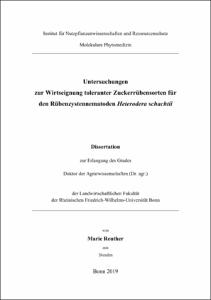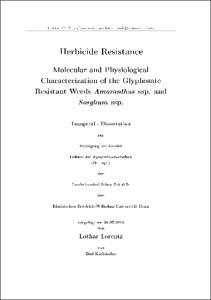Neidhöfer, Claudio: The Spread and Detection of Carbapenemase-Encoding Bacteria : Human-Microbiome-like Correlations and Opportunities for Precision Medicine. - Bonn, 2022. - Dissertation, Rheinische Friedrich-Wilhelms-Universität Bonn.
Online-Ausgabe in bonndoc: https://nbn-resolving.org/urn:nbn:de:hbz:5-65884
Online-Ausgabe in bonndoc: https://nbn-resolving.org/urn:nbn:de:hbz:5-65884
@phdthesis{handle:20.500.11811/9679,
urn: https://nbn-resolving.org/urn:nbn:de:hbz:5-65884,
author = {{Claudio Neidhöfer}},
title = {The Spread and Detection of Carbapenemase-Encoding Bacteria : Human-Microbiome-like Correlations and Opportunities for Precision Medicine},
school = {Rheinische Friedrich-Wilhelms-Universität Bonn},
year = 2022,
month = mar,
note = {Antibiotic resistance is a major problem worldwide. The rapid spread of opportunistic pathogenic carbapenemase-encoding bacteria (CEB) requires clinicians, researchers and policy makers to quickly find solutions to reduce transmission rates and the associated health burden. Epidemiological data are key to planning control measures. We analyzed 397 carbapenemase-encoding isolates that were detected between 2014 and 2019 in our laboratory with the associated demographic and clinical patient information. Two bacterial clusters were whole-genome sequenced to establish pathogen-clonality and analyze the spread-dynamics. Further we designed and tested an experimental workflow to evaluate conclusiveness and validity in transferability of our dataset.
We confirmed a significantly higher prevalence of CEB among men and discovered evidence on a role for both, residency and ethnicity in the type of CEB colonization patients were more likely to be detected with. Residency on the Arabian Peninsula was associated with a higher likelihood of carrying OXA-23-encoding A. baumannii, whereas living in Germany rather predisposed to colonization with other CEB-types such as VIM-encoding Enterobacter cloacae complex. Ethnicity was a determinant variable even among patients within the same area of residency. The way global distribution patterns of carbapenemases are seen and studied may be substantially influenced if further studies confirm ethnicity to be a variable in this regard. Screening patients from countries with a higher prevalence of A. baumannii with more sensitive than routinely used culture-media, and very importantly, with the correct specimen, given that A. baumannii is more readily detected for example in inguinal swabs, may be appropriate. The important role of P. aeruginosa among complications of prolonged hospital stays was confirmed. Patients that were colonized by VIM-encoding P. aeruginosa largely contracted it during their hospital stay; oncological patients were particularly at risk.
Our diagnostic step-by-step workflow was found to be sensitive and effective in detecting CEB. The Outbreak Analysis has highlighted two different common spread patterns and the importance of timely diagnostics and hospital-hygiene intervention. Nevertheless, our study has also shown that even when extensive safety precautions are in place, not all hospital-acquired pathogens can be equally well contained, which prompts to continuously rethink hospital-built environments such as the sinks, faucets and wastewater-network and further optimize all precautions according to risk factors and the spectrum of expected pathogens.},
url = {https://hdl.handle.net/20.500.11811/9679}
}
urn: https://nbn-resolving.org/urn:nbn:de:hbz:5-65884,
author = {{Claudio Neidhöfer}},
title = {The Spread and Detection of Carbapenemase-Encoding Bacteria : Human-Microbiome-like Correlations and Opportunities for Precision Medicine},
school = {Rheinische Friedrich-Wilhelms-Universität Bonn},
year = 2022,
month = mar,
note = {Antibiotic resistance is a major problem worldwide. The rapid spread of opportunistic pathogenic carbapenemase-encoding bacteria (CEB) requires clinicians, researchers and policy makers to quickly find solutions to reduce transmission rates and the associated health burden. Epidemiological data are key to planning control measures. We analyzed 397 carbapenemase-encoding isolates that were detected between 2014 and 2019 in our laboratory with the associated demographic and clinical patient information. Two bacterial clusters were whole-genome sequenced to establish pathogen-clonality and analyze the spread-dynamics. Further we designed and tested an experimental workflow to evaluate conclusiveness and validity in transferability of our dataset.
We confirmed a significantly higher prevalence of CEB among men and discovered evidence on a role for both, residency and ethnicity in the type of CEB colonization patients were more likely to be detected with. Residency on the Arabian Peninsula was associated with a higher likelihood of carrying OXA-23-encoding A. baumannii, whereas living in Germany rather predisposed to colonization with other CEB-types such as VIM-encoding Enterobacter cloacae complex. Ethnicity was a determinant variable even among patients within the same area of residency. The way global distribution patterns of carbapenemases are seen and studied may be substantially influenced if further studies confirm ethnicity to be a variable in this regard. Screening patients from countries with a higher prevalence of A. baumannii with more sensitive than routinely used culture-media, and very importantly, with the correct specimen, given that A. baumannii is more readily detected for example in inguinal swabs, may be appropriate. The important role of P. aeruginosa among complications of prolonged hospital stays was confirmed. Patients that were colonized by VIM-encoding P. aeruginosa largely contracted it during their hospital stay; oncological patients were particularly at risk.
Our diagnostic step-by-step workflow was found to be sensitive and effective in detecting CEB. The Outbreak Analysis has highlighted two different common spread patterns and the importance of timely diagnostics and hospital-hygiene intervention. Nevertheless, our study has also shown that even when extensive safety precautions are in place, not all hospital-acquired pathogens can be equally well contained, which prompts to continuously rethink hospital-built environments such as the sinks, faucets and wastewater-network and further optimize all precautions according to risk factors and the spectrum of expected pathogens.},
url = {https://hdl.handle.net/20.500.11811/9679}
}









